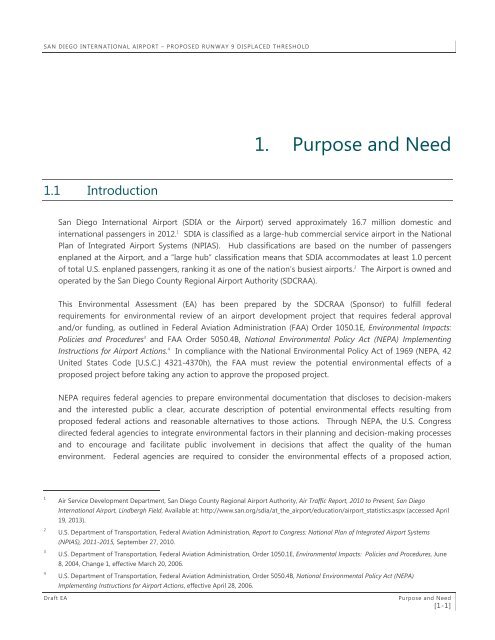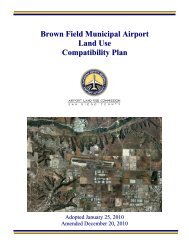Draft EA - San Diego International Airport
Draft EA - San Diego International Airport
Draft EA - San Diego International Airport
Create successful ePaper yourself
Turn your PDF publications into a flip-book with our unique Google optimized e-Paper software.
SAN DIEGO INTERNATIONAL AIRPORT – PROPOSED RUNWAY 9 DISPLACED THRESHOLD<br />
1. Purpose and Need<br />
1.1 Introduction<br />
<strong>San</strong> <strong>Diego</strong> <strong>International</strong> <strong>Airport</strong> (SDIA or the <strong>Airport</strong>) served approximately 16.7 million domestic and<br />
international passengers in 2012. 1<br />
SDIA is classified as a large-hub commercial service airport in the National<br />
Plan of Integrated <strong>Airport</strong> Systems (NPIAS). Hub classifications are based on the number of passengers<br />
enplaned at the <strong>Airport</strong>, and a “large hub” classification means that SDIA accommodates at least 1.0 percent<br />
of total U.S. enplaned passengers, ranking it as one of the nation’s busiest airports. 2<br />
The <strong>Airport</strong> is owned and<br />
operated by the <strong>San</strong> <strong>Diego</strong> County Regional <strong>Airport</strong> Authority (SDCRAA).<br />
This Environmental Assessment (<strong>EA</strong>) has been prepared by the SDCRAA (Sponsor) to fulfill federal<br />
requirements for environmental review of an airport development project that requires federal approval<br />
and/or funding, as outlined in Federal Aviation Administration (FAA) Order 1050.1E, Environmental Impacts:<br />
Policies and Procedures 3<br />
and FAA Order 5050.4B, National Environmental Policy Act (NEPA) Implementing<br />
Instructions for <strong>Airport</strong> Actions. 4 In compliance with the National Environmental Policy Act of 1969 (NEPA, 42<br />
United States Code [U.S.C.] 4321-4370h), the FAA must review the potential environmental effects of a<br />
proposed project before taking any action to approve the proposed project.<br />
NEPA requires federal agencies to prepare environmental documentation that discloses to decision-makers<br />
and the interested public a clear, accurate description of potential environmental effects resulting from<br />
proposed federal actions and reasonable alternatives to those actions. Through NEPA, the U.S. Congress<br />
directed federal agencies to integrate environmental factors in their planning and decision-making processes<br />
and to encourage and facilitate public involvement in decisions that affect the quality of the human<br />
environment. Federal agencies are required to consider the environmental effects of a proposed action,<br />
1<br />
2<br />
3<br />
4<br />
Air Service Development Department, <strong>San</strong> <strong>Diego</strong> County Regional <strong>Airport</strong> Authority, Air Traffic Report, 2010 to Present, <strong>San</strong> <strong>Diego</strong><br />
<strong>International</strong> <strong>Airport</strong>, Lindbergh Field, Available at: http://www.san.org/sdia/at_the_airport/education/airport_statistics.aspx (accessed April<br />
19, 2013).<br />
U.S. Department of Transportation, Federal Aviation Administration, Report to Congress: National Plan of Integrated <strong>Airport</strong> Systems<br />
(NPIAS), 2011-2015, September 27, 2010.<br />
U.S. Department of Transportation, Federal Aviation Administration, Order 1050.1E, Environmental Impacts: Policies and Procedures, June<br />
8, 2004, Change 1, effective March 20, 2006.<br />
U.S. Department of Transportation, Federal Aviation Administration, Order 5050.4B, National Environmental Policy Act (NEPA)<br />
Implementing Instructions for <strong>Airport</strong> Actions, effective April 28, 2006.<br />
<strong>Draft</strong> <strong>EA</strong><br />
Purpose and Need<br />
[1-1]
















